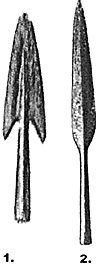In Polybios' Histories during his section on the second Punic War, he refers to troops called Longchephroi. "...Threw forward as a covering force his Longchephroi and slingers, about 8,000 in number." [Polyb His. III. 72- 6.]
"When the Roman cavalry fellback and left the flanks of the infantry exposed, the Cartbaginian Longchephroi and the Numidians in a body, dashing by their own troops in front of them, fell on the Romans from both flanks, damaging them severely." [Polyb His. III. 72. 12.]
And "his slingers and Longchephroi be brought round to the front by a detour stationing them in an extended line..." [Polyb His. III. 83. 4.]
"After the battle one Maharbal being sent by the commander with the Iberians and Longchephroi to surround the village..." [Polyb His. III. 84. 14.] and "...be sent off Maharbal with the Longchephroi and part of the cavalry." [Polyb His. III. 86. 5.] and "Placing his Longchephroi behind the army's servants, he ordered them to help the cattle) drivers..." [Polyb His. III. 92. 9.] and "When at daybreak he saw Romans on the hill opposite his Longchephroi, he sent Spanish as a reinforcement." [Polyb His. III. 94. 6.]
When Polybios was translated into English for Loab, the translator (W.R. Paton) decided that these were light pikemen. Why, I couldn't tell you. The Greek historian never has them fighting in the line of battle, they are always screening the army's advance, or deployment, or storming strongholds. He even calls them "light armed infantry." [Polyb His. III. 94. 6.] and as the final proof, he sent 2,000 of his Longchephroi in the night to occupy it (a hill). Marcus Minucius catching sight of them at day's break led out his LIGHT ARMED Leves and attacked the hill. A brisk skirmish took place in which the Romans were victorious. [Polyb His. III. 101. 6-7.]
These were apparently Libyan troops, though they might be Liby Phoenician as well. Polybios often calls then Carthaginian, to distinguish them from Iberians and Spanish light armed.
Finally, Peter Connolly in his "The Roman Army" (1977) depicted Longchephroi as heavy pikemen in captured Lorica Hamata, and presto, the Carthaginian heavy pikeman was born.
 I never believed it. But of course I had the only Roman Consular Army in my wargame group. My opponents seized on this "historical" tidbit and started
converting all their Libyan spearmen to pikemen. My legionaries did not appreciate the turn of events. "First elephants and now this?" they cried. I knew I had better research this fast.
I never believed it. But of course I had the only Roman Consular Army in my wargame group. My opponents seized on this "historical" tidbit and started
converting all their Libyan spearmen to pikemen. My legionaries did not appreciate the turn of events. "First elephants and now this?" they cried. I knew I had better research this fast.
So what exactly is a Longche-carrying troop? My Greek was good enough back then that I knew longche meant tongue in Greek. So were these guys armed with tongue depressors? Not really. But it has to do with the tongue, precisely tongue shaped. The head of the javelin carried by this light armed is tongue shaped (1), unlike the standard leaf shape (2). (See Diagram)
Why tongue shaped? All the heads we have recovered in Lybia and Spain are almost triangular, so I would say to cause hard-to-treat wounds. However that is just supposition on my part.
Why did Polybios call this particular troop by this name? I'd venture an educated guess. In his period, warfare was almost unknown in Greece. The Pax Romana saw to that. So warfare was studied almost theoretically. Colorful names for troop types were invented. For example a light cavalryman carrying a large shield was called a Tarrentine even if he wasn't from that city. The Aetolian peltast was such a good mercenary infantryman that Aetolian began to replace the word mercenary, or the two could be used interchangeably.
Since the light armed of the Successors were using standard leaf shaped javelin heads, Polybios seized on this distinction to add a little more color to his narrative, much like Ian Fleming did with his character, 007. James Bond didn't just carry a gun, he carried a 1937 Walther PPK 7.62mm automatic.
The Libyans were not just light armed carrying javelins, they were longchephroi! See how that works?
Back to Strategikon Vol. 1 No. 3 Table of Contents
Back to Strategikon List of Issues
Back to MagWeb Master Magazine List
© Copyright 2001 by NMPI
This article appears in MagWeb (Magazine Web) on the Internet World Wide Web. Other military history articles and gaming articles are available at http://www.magweb.com